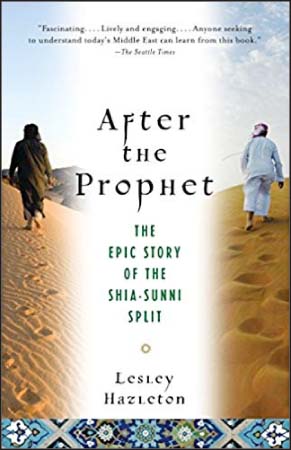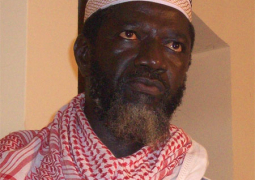
Reviewed
by Z. Hussain
Before
it was just plain ‘Muslim’, but we now live in era where the words ‘Sunni’ and
‘Shia’ are bombarded at us from every direction, whether we belong to the
religion of Islam or not. The lay person is now asking what the difference is
and why they seem to be at war with each other. Those of us who have grown up
in the faith or are a part of the faith are well aware of the differences
between both sects. However, when explaining these issues to the people asking
the questions, many just don’t understand how events in the past could lead to
what is going on today.
“They
told different versions of the same story, disagreeing not on what had taken
place in the seventh century but on what it meant.”
Enter
Lesley Hazleton’s book, which aims to provide a purely historical context,
sprinkled with some theology, on the root cause of the schism between Sunni and
Shia and how it permeates the whole world. It is imperative for the readers of
this book to remember this isn’t a polemical discussion attempting to persuade
you one side is correct. Whether you are a Muslim or not, the book is a pure
historical narrative of what happened after the death of Prophet Muhammad
(peace be upon him). Hazleton empathises with how muddy this topic can be due
to the fact that both schools of thought affirm/deny certain historical events
but does her best to bring both sides together. Predominantly though, these are
her conclusions on this part of history.
Let
us first get one thing straight – if you are a Sunni or Shia Muslim, there will
be plenty of parts of the book you will not agree with, be it the claims it
makes about the Islamic history or theology of each group (e.g. the Sunni
reader may not welcome how Hazleton narrates the ‘Incident of the Door’; the
Shia reader may not take kindly to how Hazleton claims Imam Hassan (peace be
upon him) could not forgive Imam Ali (peace be upon him) for betraying his
principles by warring at Siffin). That said, Hazleton has clearly done her
research, as the bibliography indicates, and uses a breadth of credible sources
in her writing. One should not have any qualms in using this book as an
academic source because it is excellently referenced.
The
book is split into three chapters named simply after the three primary figures
the Shia-Sunni split revolves around:
1.
Muhammad
2.
Ali
3.
Hussein
Interestingly,
and maybe controversially, the common theme running through each of the
chapters is Ayesha, one of the wives of Prophet Muhammad (peace be upon him and
his family), who Hazleton seems to be completely fascinated with. Hazleton is
able to really explore the psychology of Ayesha and gives an excellent insight
into her character and her controversial actions. The same in-depth analysis is
also given to Muawiya where the reader is able to really understand his cunning
nature and ongoing feud with Imam Ali (peace be upon him).
“Charming
she must have been, and sassy she definitely was. Sometimes, though, the charm
wears thin, at least to the modern ear. The stories Aisha later told of her
marriage were intended to show her influence and spiritedness, but there is
often a definite edge to them, a sense of a young woman not to be crossed or
denied”
The
beauty of the book lies in how Hazleton is able to transport the reader to this
epoch of Islam. She writes in such a way where you feel you are standing in the
middle of each pivotal event of Islam and experiencing them using all five
senses. The way she describes the ‘Pen & Paper Incident’, the reader feels
they are standing next to the bed of Prophet Muhammad (peace be upon him and
his family) witnessing the heated argument. When she describes the ‘Battle of
the Camel’, one feels they are on the battlefield witnessing the turmoil of
Muslims at war with each other.
The
strongest aspect of the book may be seen as its downfall by some (Shia Muslims
in particular). Many traditional Shia Muslims have been raised to believe the
family of Prophet Muhammad (peace be upon them all) were these celestial beings
on earth who always performed miracles and were ‘superhuman’. Although this may
not be entirely inaccurate, such people may find it uncomfortable reading to
see the family of Prophet Muhammad (peace be upon them all) portrayed simply as
human beings with emotions, desires and feelings like us, rather than on a
lofty pedestal. Yes, they are acknowledged as having excellent morals and
principles but are ultimately flawed heroes. Although Shias should reject such
a take on the family of the Prophet (peace be upon them) it is still absolutely
fascinating to see them portrayed as ‘humans’ as it is a perspective that is
neglected in Muslim circles.
“Yet
it is also an altogether human scene. Everyone so concerned, everyone crowded
around, trying to protect Muhammad from the importuning of others, to ease life
for a mortally ill man. They were all, it seemed, doing their best. But as
their voices rose in debate over the pros and cons of calling for pen and
paper, the terrible sensitivity to noise overtook Muhammad again.”
Lesley
Hazleton may not be a Muslim but she is well qualified to write this book when
looking at her credentials and her wonderful talks on various platforms
where she discusses Islam; in the book she mentions narrations and traditions
that Muslims may not have heard of before, so even those who think they know
all there is to know about the Shia-Sunni split will learn something new. One
really hopes that Muslims who read this book do not reduce its validity because
it was written by a non-Muslim; she demonstrates more knowledge than many
Muslims.
“If
Ali was the foundation figure of Shia Islam, Hussein was to become its
sacrificial icon. The story of what happened to him once he reached Iraq would
become the Passion story of Shiism—its emotional and spiritual core.”
What
is amazing is how she ‘gets’ it. She ‘gets’ why events 1400 years ago are still
shaping the actions of people today. She ‘gets’ the emotion underpinning the
Shia-Sunni split whereas others brush it off as merely ‘history’ or ‘politics’.
Perhaps, most importantly, she ‘gets’ Karbala. Her discussion on how Imam
Hussain’s tragedy is used for internal and external revolution will have
resonance with Shia readers; the book even opens with a narrative of the
bomb-blast in Karbala in 2004 on the day of Ashura and later on she details the
events of Ashura itself which will bring tears to the eyes of those who hold
Imam Hussain dear to their hearts.
If
you are a Muslim who is bored of the Shia-Sunni debate, it may refresh you
after reading this from a unique perspective. If you are not a Muslim, it is an
excellent starting point to understand the context of why certain events are
taking place in the world today. However, it may be beneficial to then speak to
members of the Sunni and Shia community to further expand on what is in the
book. Excellently written with some striking quotables and vivid imagery,
perhaps the book is not a ‘must-read’ but it certainly is one you should read.
Available
at Timbooktoo tel 4494345
Read Other Articles In Article (Archive)



